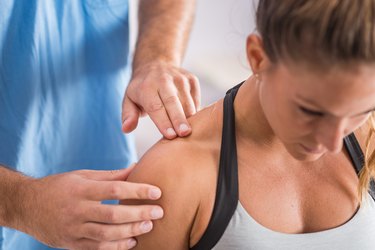
The trapezius, the large muscle of the back, is responsible for moving the shoulders and neck and supporting the arms. Overuse — through weightlifting or carrying heavy objects — may lead to muscle strain or a partial tear of the trapezius muscle, which may be mild — first-degree — or moderate — second-degree. Symptoms include pain and difficulty moving the shoulders and neck. Treatments include home remedies, physical therapy and medication.
Tip
Treatment for a trapezius muscle tear can range from home remedies to surgery, depending on the severity of your injury.
Video of the Day
Home Treatment for a Trapezius Tear
Immediately after injury, the muscle should be rested. Lifting of objects should be avoided. Application of ice to the back will reduce inflammation at the site of muscle injury but will do little to relieve pain. After a few days, the muscle should be used to prevent loss of muscle mass. Early mobility of the muscle has been shown to lead to more rapid muscle healing and less scar tissue formation.
Video of the Day
Physical Therapy Interventions
The American Academy of Orthopaedic Surgeons suggests several exercises to strengthen the trapezius after injury. Some examples include shrugging the shoulders, neck rotation, lateral arm raises with weights while lying on a table and the standing row, in which the patient pulls the elbows back while holding a fixed elastic band and squeezing the shoulder blades together. The use of rowing machines is also recommended. After physical therapy, deep massage is a useful technique to decrease scar tissue formation, prevent more injury and encourage muscle relaxation.
Additionally, physical therapists use modalities such as ultrasound, cold laser and electrical stimulation to help decrease pain and inflammation that can occur with a trapezius strain. A therapist can also help address the way you perform your daily tasks to help prevent future injury to your trapezius muscle.
Therapeutic Ultrasound Treatment
Therapeutic ultrasound pulses high-frequency ultrasound waves into the muscle. Effects are believed to be due to heating of the tissues from the ultrasound wave and the creation of a micro-massage from the pulsating ultrasound waves. There is controversy about the usefulness of therapeutic ultrasound. However, a study published in 2014 by the Journal of Physical Therapy Science indicates that ultrasound is effective for decreasing stiffness and improving range of motion.
Medications for Trap Tear
Nonsteroidal anti-inflammatory drugs, or NSAIDs, have been shown to lead to a decrease in the inflammatory response that occurs with muscle tears. These can be obtained over the counter, such as ibuprofen (Motrin, Advil), or may be prescribed by a doctor at higher doses.
NSAIDs should primarily be used immediately after muscle injury, however. Long-term use of these over-the-counter medications may adversely affect muscle healing. Corticosteroids have been shown to be detrimental by delaying muscle repair and reducing the muscle strength. Check with your doctor to be sure a medication is safe for you.
Warnings and Precautions
See a doctor for your trapezius strain if your back pain worsens, continues for more than 48 hours or is severe. If significant swelling or bruising over the back or neck is present or if there is difficulty moving the arm or neck on the injured side compared to the uninjured side, you should also seek medical care.
- National Institute of Arthritis and Musculoskeletal and Skin Diseases: Sports Injuries
- British Journal of Sports Medicine: Terminology and Classification of Muscle Injuries in Sport: The Munich Consensus Statement
- Mayo Clinic: Muscle Strains
- Journal of Physical Therapy Science: Effects of Therapeutic Ultrasound on Range of Motion and Stretch Pain
- American Academy of Orthopaedic Surgeons: Rotator Cuff and Shoulder Conditioning Program
Is this an emergency? If you are experiencing serious medical symptoms, please see the National Library of Medicine’s list of signs you need emergency medical attention or call 911.